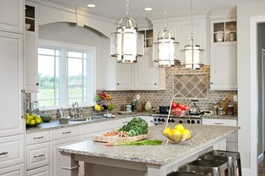To Dim or Not to Dim
December 17, 2015
If you haven’t flipped the switch to ENERGY STAR® certified dimmable LEDs, now is the time! As Massachusetts families settle in for a long winter of feasting, watching movies, playing games, and other indoor activities, dimmer switches can be the deciding factor in creating the perfect, cozy atmosphere. Installing dimmer switches with compatible light fixtures not only saves energy, but also allows you to tone down too-bright ambient lighting and have more control over the mood of a room. Plus, installing ENERGY STAR certified dimmable LED bulbs in compatible dimmable fixtures can extend the life of your bulbs and minimize the need to change out bulbs in those hard-to-reach fixtures.
To help make your next trip to the lighting aisle (or to our online storefront) a little less confusing, we’re shedding some light on the topic of dimmable energy-efficient lighting.
Why Dim?
You do a lot of living in your home, and your lighting should be adaptable enough to set the stage for a wide range of activities. Dimming not only provides options, but also increases savings potential by allowing for periods of lower energy use without turning the lights off all the way.
If you would like to be able to control the brightness of an LED bulb, you will need one that is dimmable. Dimmers and other lighting controls allow you to adjust light levels for specific entertainment preferences, set a mood and provide safe and comfortable environments.
Plan for Placement
Slide, rotate, tap: there’s a variety of dimmer switches that operate differently, including standard incandescent dimmers, LED compatible dimmers, rotary dimmers, and in-line lamp dimmers. Traditional dimmers work by limiting the amount of electricity sent to the bulb. As they were designed to work with incandescent bulbs, they are not always suitable and may actually interfere with the performance of LEDs. Pairing dimmers and bulbs that are incompatible can result in flickering light, limited dimming range, slow start-up, buzzing, inconsistent illumination and decreased lifetime of the bulb.
If you are going to be using LED bulbs, the easiest way to avoid these issues is to make sure you have a compatible or universal dimmer switch. You can determine compatibility by checking the packaging or through an online search. Many major dimming switch manufacturers, such as Lutron and Leviton, provide a comprehensive listing of compatible light bulbs for all of their dimming switches.
Universal dimmers are designed to control incandescent, halogen and dimmable LED bulbs. They offer full-range dimming and eliminate flickering and fluttering of lights. When using LED bulbs with a dimmer, it’s key to check the packaging to ensure that the bulb is dimmable. While a dimmable bulb can be used in a non-dimmable socket, a non-dimmable bulb is limited to non-dimming sockets. If you don’t already have a universal dimmer installed, this is an easy upgrade. You can find universal dimmers at your local home improvement or hardware store or online.
Dimmable Usage Tips
- For multipurpose rooms, dimmers are essential. In living rooms, use a combination of floor lamps, table lamps and downlights (recessed or track lighting).
- Add balance to your kitchen. Typically, lights are on in the kitchen
 more than in any other room in the home. If you also have a table in your kitchen, a dimmable overhead fixture providing light in a warmer color temperature can create a more comfortable mood to balance out the brighter blue lights over the kitchen counters.
more than in any other room in the home. If you also have a table in your kitchen, a dimmable overhead fixture providing light in a warmer color temperature can create a more comfortable mood to balance out the brighter blue lights over the kitchen counters. - A combination of ambient, task and accent lighting can make your dining room both beautiful and functional. Multiple fixtures and dimmable bulbs will allow you to create “layers of light” to vary the ambience and provide the light you need for any type of dining experience. Chandeliers are commonly the centerpiece of a dining room’s lighting. ENERGY STAR certified dimmable chandelier and candelabra bulbs are a great way to vary the illumination to your preference.
- Mix old with new by updating antique table lamps with ENERGY STAR certified bulbs. If you find that the lampshade sits crooked or too low, a simple change out to a larger harp (the metal accessory that connects the lampshade to the lamp) will even things out!
- Choose the right color temperature to set different moods in each room. Light color is measured on a temperature scale referred to as Kelvin (K). Lower Kelvin numbers mean the light appears more yellow; higher Kelvin numbers mean the light is whiter or bluer. A 2700-3000K bulb will match the yellow color of incandescent bulbs. For whiter light for kitchens or work spaces, look for bulbs marked 3500-4100K. For bluer white light that’s ideal for reading, look for bulbs marked 5000-6500K. You can learn more about how Kelvins affect lighting appearance by watching our video on lighting.
Remember, for all of your lighting needs, look for bulbs with the ENERGY STAR to save energy and money. To find ENERGY STAR Lighting Tools and Tips, click here.
If you liked this blog, be sure to follow us on Twitter @MassSave and on Facebook to learn about future posts, get tips to help you save energy and money, and access exclusive promotions!
Lighting & Appliances
Explore More Topics
Personalized Energy Saving Solutions
MyEnergy provides customized content based on your location and energy needs.